


|
Joined:
|
05/02/2011 |
|---|---|
|
Last Updated:
|
02/03/2011 |
|
Location:
|
Texas, United States |
|
Climate Zone:
|
Warm Temperate |
|
Gender:
|
Male |
|
Web site:
|
eco-pioneers.org |
(projects i'm involved in)
(projects i'm following)
Back to Theron Beaudreau's profile
Posted by Theron Beaudreau almost 11 years ago
Working with damaged soils can be a huge challenge. In the world we live in today, it's hard to find soils that haven't been damaged through agricultural or urban misuse. If you are one of those lucky few who stumbled on a piece of land that already had pristine, rich deep and loamy soils than rejoice because you need not read any further... Still here? Yea, thought so. Most of us in permaculture design are working with or at least, have started out with, damaged, desiccated, mineral depleted, lifeless soils. One way or another, we have been tasked with reviving our soils from generations of abuse. But how do we return the basic building blocks of life to the soil quickly and efficiently so that we can get on with the high yielding polycultures we keep dreaming about? Enter - Bio-Fertilizer!
While interning at the Permaculture Research Institute in Australia I got my first taste (I did NOT actually taste it... and I don't recommend anyone else try to taste it - it's for the soils not the guts) of soil remineralization through Bio-Fertilization. During a Soil Biology course with Paul Taylor, we learned about compost, compost tea, and the relationships between various soil microorganisms. One piece that clearly stuck out for me was the understanding of the role of anaerobic versus aerobic microbes within this complex life web.
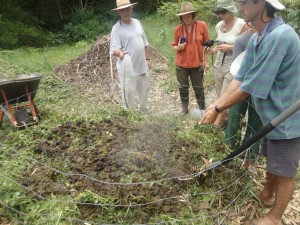 Paul pointed out how important it is to maintain aerobic soils. Meaning, healthy soils are aerated soils with a lot of organic life and rich mineral content. To create aerated soils we need to promote the growth of aerobic bacteria. These are generally the bacteria that inhabit our compost and compost teas (so long as we are cultivating proper compost and compost tea!)
Paul pointed out how important it is to maintain aerobic soils. Meaning, healthy soils are aerated soils with a lot of organic life and rich mineral content. To create aerated soils we need to promote the growth of aerobic bacteria. These are generally the bacteria that inhabit our compost and compost teas (so long as we are cultivating proper compost and compost tea!)
Aerobes, organisms that survive and thrive in oxygenated environments, help to create porous soils with a lot of area for water and air to seep in and stay put. Building a sponge like humic layer, aerobes are hard at work for us binding together various soil aggregates and other organic materials with their glue like excretions.
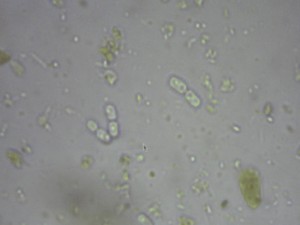 Anaerobes, on the other hand, thrive in environments that lack oxygen. These, often smelly, little microbes are keen to compact our soils. Desiring an environment that lacks oxygen, the biofilm excretions of these guys serves to seal up those porous soils you've worked so hard on. This is why it is so important to create a balanced compost system and highly aerate compost teas. Breeding anaerobes is asking for trouble!
Anaerobes, on the other hand, thrive in environments that lack oxygen. These, often smelly, little microbes are keen to compact our soils. Desiring an environment that lacks oxygen, the biofilm excretions of these guys serves to seal up those porous soils you've worked so hard on. This is why it is so important to create a balanced compost system and highly aerate compost teas. Breeding anaerobes is asking for trouble!
Then, why am I so excited about an anaerobic fertilizer? Well, permaculture is not about prescribing human notions of right and wrong, good and bad, to the world around us. Permaculture simply asks us to observe what is, and design accordingly. Through this objective way of understanding our world, new patterns, previously clouded by our prejudice, begin to emerge (The principles "The Problem is The Solution" and "Everything Gardens" come to mind here).
That is what makes the anaerobes so exciting! When we stop placing judgments on how they smell or their preference for compacted soils, we start to recognize patterns of behavior that can be leveraged to our benefit as well as ways in which less than beneficial behavioral patterns can be limited.
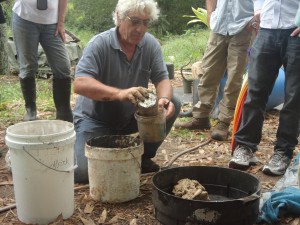 During our 5 day soil course at the PRI, we learned that one of the many patterns of anaerobic microbes (particularly those that inhabit the gut of ruminant animals) is their proficiency at breaking down minerals in their environment. If you still harbor a prejudice toward these little guys, you might be thinking, "Oh no! They're going to eat up all the minerals in my soil! How can that be a good thing?"
During our 5 day soil course at the PRI, we learned that one of the many patterns of anaerobic microbes (particularly those that inhabit the gut of ruminant animals) is their proficiency at breaking down minerals in their environment. If you still harbor a prejudice toward these little guys, you might be thinking, "Oh no! They're going to eat up all the minerals in my soil! How can that be a good thing?"
It's true, anaerobes are going to eat up all kinds of minerals... and with smart design, we can leverage this to our advantage! This is where Bio-Fertilizer anaerobic digestion comes in. You see, once a mineral element finds its way into the body of a microorganism, it becomes available to other microorganisms. In this way, mineral elements can be begin to climb the food chain and eventually reach your plants - and, from our plants, these important nutrients eventually find their way into ourselves and our families.
In conventional agricultural systems we tend to think of the soil as a lifeless medium with the sole purpose of holding our plants upright. If microorganisms in the soil are considered, they are typically considered a threat to be eradicated. It is up to the plant, and the plant alone, to extract all the elements it needs to grow and stay healthy. So, when the soil is lacking in a particular nutrient, we simply apply that nutrient in the recommended dosages and wait for plant health to improve. When the health of our plants doesn't improve, or only improves very marginally, we assume we need to add more, and more often, to obtain our desired result. All the while, our minerals, and all our hard work, and plenty of money, are all being washed down the not so proverbial drain as water-soluble nutrients get carried away with each watering.
What we've done is completely neglect a very important and very complex part of the process. By missing this important link in the chain of nutrient cycling, living soil, we've increased our work load, created unintended problems beyond the scope of the one we intended to resolve, and put ourselves on a treadmill of continual supplementation.
Microorganisms are not only a delivery vehicle for mineral nutrients to the plant roots, they also help prevent nutrients from washing away in the first rain event. As a result, minerals stay in the soil where they are needed, instead of in the ground water or rivers where they can be a pollutant. It behooves us to use these microscopic muscles to take care of the heavy lifting and save our precious time and money by holding on to vital nutrients and deliver them to our plants, where we want them.
But how do we manage to accomplish this without creating the compacted (and smelly) conditions anaerobes are known for? As you might have guessed, proper use of Bio-Fertilizers provides some answers.
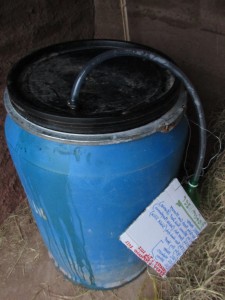 Bio-Fertilizer, as will be described here, is an anaerobic fermentation process used to secure vital minerals in bio-available form. In these bio-available forms, these minerals are less susceptible to leaching and more available to plant roots than minerals just scattered on the ground. But left to their own, they can create harmful conditions in your soil - to use them properly, they must be teamed up with the aerobes in our compost and compost teas.
Bio-Fertilizer, as will be described here, is an anaerobic fermentation process used to secure vital minerals in bio-available form. In these bio-available forms, these minerals are less susceptible to leaching and more available to plant roots than minerals just scattered on the ground. But left to their own, they can create harmful conditions in your soil - to use them properly, they must be teamed up with the aerobes in our compost and compost teas.
Using a controlled environment (in this case a airtight 200lt. drum) we create a suitable habitat for our little anaerobes. Combining soluble minerals, a food source and the bacteria from a ruminate animal, we set in set in motion a fermentation process that will take about 2 months to complete. By the end of the fermentation process it is mostly safe to assume the bacteria have had an opportunity to consume most of the minerals provided.
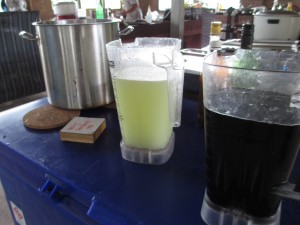 There are several recipes that might be used depending on your soil's needs. In the tropics and subtropics, where slash and burn agriculture disperses minerals into the atmosphere and monsoons washout the little that remains, Bio-Fertilizers are particularly important to help replace these highly mobile nutrients. Soils test will help you determine what minerals might be in short supply and help you create a recipe that works best for your soil conditions.
There are several recipes that might be used depending on your soil's needs. In the tropics and subtropics, where slash and burn agriculture disperses minerals into the atmosphere and monsoons washout the little that remains, Bio-Fertilizers are particularly important to help replace these highly mobile nutrients. Soils test will help you determine what minerals might be in short supply and help you create a recipe that works best for your soil conditions.
Regardless of the specific recipe used, the basic elements remain the same. First, you'll need an airtight container with an airlock. These can be assembled out of basic materials that are readily available just about anywhere. In the video, we used a 200lt. container with a locking airtight lid. We then added an airlock using a 1/2" rubber grommet, a terminal coupling, hose, and water bottle. Drilling a whole in the lid of the drum we insert the grommet and terminal coupling. We then attach a hose to the terminal coupling using a hose clamp and insuring that all attachments are airtight (very important!). The hose is then inserted into a half-full reused soda or water bottle attached to the drum lid with a wire. Make sure the hose is fully submerged in the water inside the bottle or the airtight seal is lost. The airlock allows air to escape the 200lt. drum so that pressure does not build up but also maintains the integrity of the oxygen free environment.
In the video, we use the following simple ingredient list:
The ingredients for the microbe food are combined in a large bowl separately. These ingredients promote the growth of the yeast as well as the bacteria in the manure.
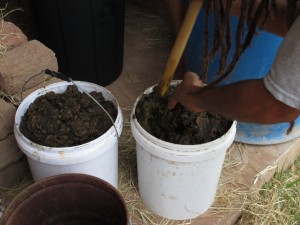 Next, 40 - 50 liters of calf or cow manure are added to the 200lt. drum. It is best to add the mature before adding the water... otherwise, you might get manure water back-splashing on you as you try to add the manure.
Next, 40 - 50 liters of calf or cow manure are added to the 200lt. drum. It is best to add the mature before adding the water... otherwise, you might get manure water back-splashing on you as you try to add the manure.
If you have access to fresh rumen, this is preferred. It is the bacteria in the rumen that are doing the heavy lifting here so if we can get them directly from the rumen our chances of success are greatly enhanced.
After the manure or rumen are added, we add our water, mineral elements and microbial food. Finally, we add the yeast, mix the concoction thoroughly and seal it up. The yeast is used to quickly consume all the available oxygen inside the drum so that the bacteria in the rumen can do their work.
 Over the next two months, this brew will ferment and the bacteria will be given a chance to completely consume all the mineral elements. The ferment should be left in a cool dark space for the two month fermentation process where it won't be disturbed. Check occasionally to insure the hose is still submerged in the water and all the fittings are airtight.
Over the next two months, this brew will ferment and the bacteria will be given a chance to completely consume all the mineral elements. The ferment should be left in a cool dark space for the two month fermentation process where it won't be disturbed. Check occasionally to insure the hose is still submerged in the water and all the fittings are airtight.
After two months, remove the lid from the container. The brew should smell like a ferment. If it smells putrid (like death or rotting flesh) it should be disposed of in the safest way possible... DO NOT SPRAY THIS ON YOUR CROPS (the putrefying bacteria are often pathogenic so be sure to dispose of a bad brew appropriately)!!
 Once you are confident that the smell is of a fermentation and not a putrification, the mixture should be thoroughly aerated (vortexing and bubbling should both work fine) and sprayed out with a aerobic compost tea. The process of aeration kills most of the anaerobic bacteria and gives favor to the aerobes in the compost tea. In this way, the anaerobes are disfavored and not given the opportunity to cause any damage to the soil's ecosystem while the mineral elements are maintained inside the dead and dying bodies of these anaerobes. When sprayed out with a healthy aerobic compost tea, the minerals move into an even more plant available form inside the bodies of aerobes.
Once you are confident that the smell is of a fermentation and not a putrification, the mixture should be thoroughly aerated (vortexing and bubbling should both work fine) and sprayed out with a aerobic compost tea. The process of aeration kills most of the anaerobic bacteria and gives favor to the aerobes in the compost tea. In this way, the anaerobes are disfavored and not given the opportunity to cause any damage to the soil's ecosystem while the mineral elements are maintained inside the dead and dying bodies of these anaerobes. When sprayed out with a healthy aerobic compost tea, the minerals move into an even more plant available form inside the bodies of aerobes.
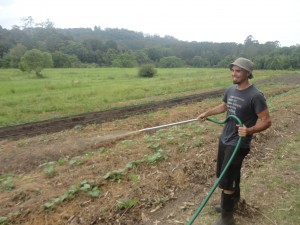 The results are dramatic and much more than you can get from just compost tea alone. Effectively remineralizing soils is a critical process that is missing out of most rehabilitative practices today. Generations of exploitative and extractive behaviors have left our soils depleted and can hamper our attempts to produce yield. The minerals that have been washed away and extracted through shortsighted agricultural practices have to be replaced somehow. By continuing to observe the patterns of nature, eliminating our prejudices and applying our design minds we can find solutions to any problems that confront us.
The results are dramatic and much more than you can get from just compost tea alone. Effectively remineralizing soils is a critical process that is missing out of most rehabilitative practices today. Generations of exploitative and extractive behaviors have left our soils depleted and can hamper our attempts to produce yield. The minerals that have been washed away and extracted through shortsighted agricultural practices have to be replaced somehow. By continuing to observe the patterns of nature, eliminating our prejudices and applying our design minds we can find solutions to any problems that confront us.
Happy fertilizing!
Special thanks to HolisticRegeneration.co.uk and Eco-Pioneers.org
You must be logged in to comment.


| Permaculture Design Certificate |
| Type: Permaculture Design Certificate (PDC) course |
| Verifying teacher: Dick Pierce |
| Other Teachers: Kirby Fry, Selwyn Polit, Jenny Nazak, Betsy Ross |
| Location: Austin Texas |
| Date: Feb 2009 |

| Radical Urban Sustainability Training (R.U.S.T) |
| Type: Other |
| Verifying teacher: Scott Kellogg |
| Other Teachers: Dr. Lauren Ross, Stacy Pettigrew |
| Location: Austin Texas |
| Date: Oct 2007 |

| PRI Earthworks Course |
| Type: Earthworks |
| Teacher: Geoff Lawton |
| Location: Zaytuna Farm |
| Date: Oct 2011 |

| Permaculture Urban Landscape Design Course |
| Type: Internship |
| Verifying teacher: Nick Huggins |
| Other Teachers: Geoff Lawton |
| Location: Zaytuna Farm |
| Date: Nov 2011 |

| Permaculture Design Course Teacher Training |
| Type: Teacher Training |
| Teacher: Geoff Lawton |
| Location: Zaytuna Farm |
| Date: Nov 2011 |

| Compost Soil Biology Natural Fertilizer Course |
| Type: Soil Biology/Compost |
| Teacher: Paul Taylor |
| Location: Permaculture Research Institute of Australia |
| Date: Nov 2011 |

| Permaculture Project Aid Workers Course |
| Type: Aid Worker |
| Verifying teacher: Geoff Lawton |
| Other Teachers: Nadia Abu Yahia Lawton |
| Location: Zaytuna Farm |
| Date: Nov 2011 |

| Permaculture Internship Program |
| Type: Internship |
| Verifying teacher: Geoff Lawton |
| Other Teachers: Nadia Abu Yahia Lawton, Nick Huggins, Tim Barker, Paul Taylor |
| Location: Permaculture Research Institute of Australia |
| Date: Oct 2011 |

| Permaculture Teachers Training |
| Type: Teacher Training |
| Teacher: John Champagne |
| Location: Rak Tamachat Thailand |
| Date: Jul 2012 |

| Restoration Agriculture Workshop |
| Type: Other |
| Teacher: Mark Shepard |
| Location: Shreveport, Louisiana |
| Date: Nov 2014 |
| 6 PDC Graduates (list) |
| 7 PRI PDC Graduates (list) |
| 2 Other Course Graduates (list) |
| have acknowledged being taught by Theron Beaudreau |
| 4 have not yet been verified (list) |
| Theron Beaudreau has permaculture experience in: |
|---|
| Warm Temperate |
| Mediterranean |
| Island |
| Sub tropical |
| Wet/Dry Tropical |
| Semi Arid |